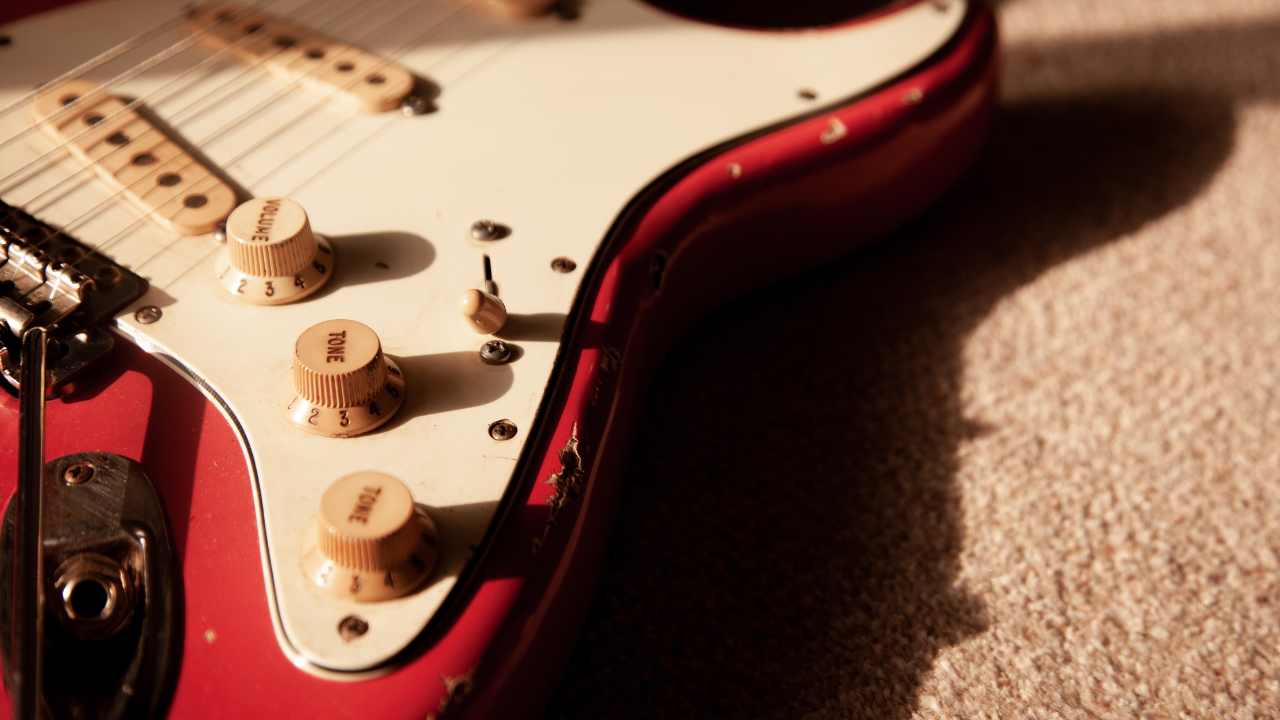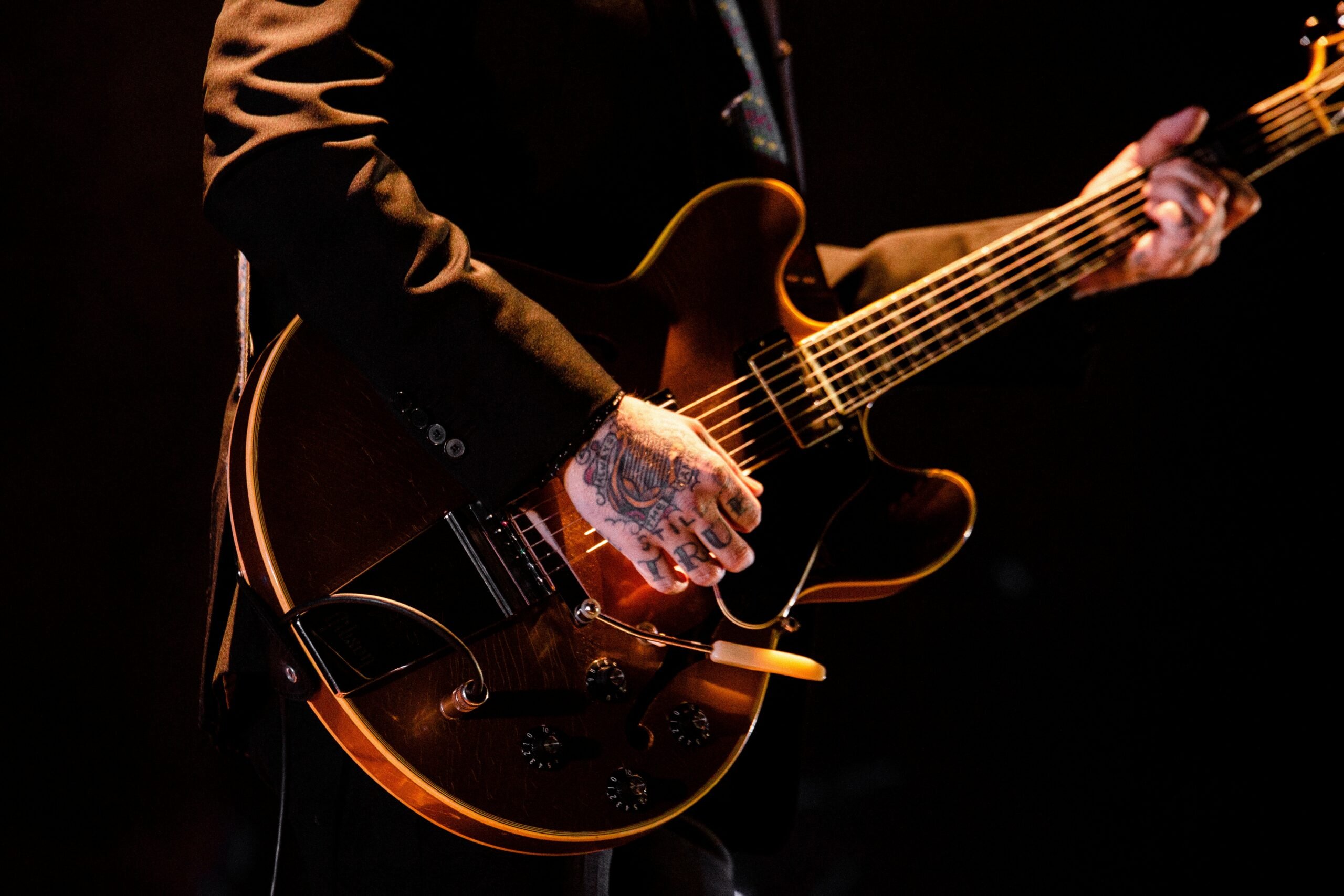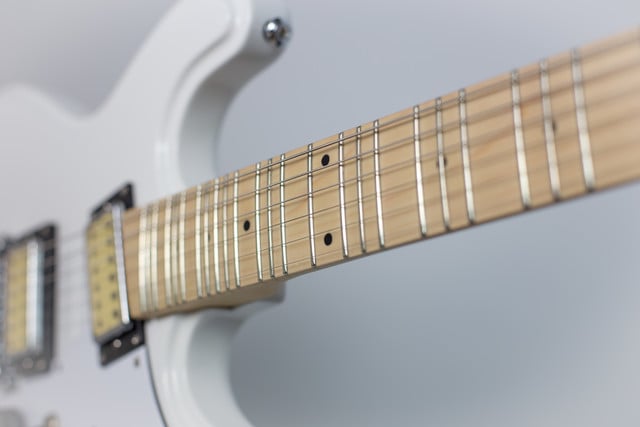Most guitar string sets are designed for standard tuning, so what do you do if you play in lower alternate tunings, AKA drop tunings? Well, you watch this video, that’s what!
Since this video went live we’ve released a new tool that you will love even better than the spreadsheet we use in the video. Check out the Stringjoy Guitar String Tension Calculator.
Subscribe to Stringjoy on YouTube
Transcription
Today, we’re talking a little bit about how to pick the right string gauges for when you’re downtuning on your guitar—whether that’s for Djent or not. Whether you’re going down to drop D full time or drop C, drop B, drop A, et cetera, these same principles are going to hold true for you.
I did a quick Google search before I recorded this video to see what sort of other information was out there on the subject, and honestly, I found a ton of misinformation. I’d be really careful what you read online about this stuff because there’s a lot of different things that don’t really work in practice. I’m not sure where people got certain ideas from or what they’re basing them off of. We’ll go through a few of them in this video, things like progressive tension or things like which particular off the rack sets people usually recommend for drop tuning. We’ll talk about why those are not necessarily the best idea.
If you haven’t seen our last video where we talk about balance tension, that could be worthwhile to watch. We talk about a few concepts in that one that continue through to this one. I’ll try to catch you up a little bit on them, but if anything’s confusing, I would check out our Balanced Tension Guitar String Video.
All right. First off, let’s take a look at what it’s like if you’re playing in drop D with a typical 10 to 46 set of strings. As you can see on here, the tension on the high strings isn’t great, we would typically use a 13 and a half there to balance that out a little bit better. But on the low strings is where it’s really not good. Your fourth and fifth strings are, of course, just fine, but the sixth string is way, way, way down here in terms of tension and we’re talking about pounds tension versus the fifth string that it’s next to. This is going to feel like a wet noodle. This is why you get those sets of strings where everything is just really, really floppy. It’s not very good at all.
Because of that, a lot of people, naturally, will use heavier gauge sets of strings. I think the most common one that I see is like a light top, heavy bottom, or a skinny top, heavy bottom set of strings, which typically goes 10, 13, 17, 30, 42, 52. Right now I have this laid out in just standard tuning with an E at the bottom. As you can see here, this gauge set of strings already takes this big jump from the fourth to the fifth string, it’s not a terrible jump, but it’s a bit of one, and then falls way off when it comes to that 52. Already, you have a lot less tension on the 52, even at standard.
Let’s see what happens when we take that down to drop D. Alright, so now you can see there’s a solid nine pounds of tension difference between that 42 and that 52. That is far from good. We could do some things to try to patch this up a little bit, going with a 40 there would kind of smooth that slope down a little bit from the 30 to the 52, but ultimately this still is not a very great solution for playing in drop D.
From looking at this, it seems obvious that a heavier gauge is going to be needed on the six string. The question ultimately is how heavy of a gauge is it appropriate to put down on that six string in order to balance everything out. First off, let’s see, if we were only looking at the tension, just trying to balance everything out really, really evenly, what gauge of string you would want on that six string to match up with a 30 and a 40. We went ahead and pulled that down from a 42. Let’s take a look. All right. Let’s try a 58. Close, but not quite there. Let’s go with a 60. That’s a little bit better.
This is what we would call a much more balanced, from a tension perspective, set of strings for drop tuning. We have 30, 40, and then a big old 60 on the bottom here. As you can see, the tension matches up pretty closely, we’re within about one or two pounds ultimately between those wound strings. The trouble there is that a 60 is a way, way heavier gauge of string than the 40 that it’s next to.
This poses two problems really. First of all, having that big of a diameter jump between those two strings is going to feel a little bit unnatural for you as a player. Having a really, really big meaty sixth string can just feel a little bit weird when you’re coming to it from playing a fifth string that’s a lot lighter.
The second problem is that you’re going to have a lot more volume on that string just because of the increased mass on the string. Now, that can be compensated for if you really want to play around with the pole pieces on your pickups or adjust everything there to make it fit a lot better. But ultimately no matter what you do, it’s going to be a little bit awkward.
What do you do if a 52, in this circumstance, is way too light next to a 30 and a 40 but a 60 that actually balances in terms of tension is going to way too big of a jump? Where is that happy medium? Ultimately this can vary a bit from player to player. Personally, I like to go with a 54 or a 56. 54 is still going to have quite a bit of jump down in tension but it’s only about four pounds which is a lot better than nine pounds, or you can go all the way up to something like a 56 and get that quite a bit closer. Again, you’re about three pounds away.
You’re still going to have to make a few adjustments depending on which of these options you go with. If you go with the 56, you might start to see some of that big volume disparity come into play. If you go with the 54, you might ultimately feel that your string is still a little bit too floppy. It just varies depending on how you are as a player. Ultimately, I recommend trying a few different options and seeing what works best for you.
Now, let’s go back to our 10 to 46 set real quick. Let’s say you don’t really see any need to boost the gauge on the fourth and the fifth strings since you’re not changing the tuning on those strings. You just want a sixth string that’s going to feel just right for drop D. Again, as we can see that 46 is really not doing us many favors at all. We have a five and a half pound difference there. But if we go where we need to go to balance everything out a bit better, we would have to go all the way up to a 54 which would balance just right but, again, cause some issues for certain players. This is not a wrong approach if you’re willing to make your guitar work for it. But ultimately I think that you can do a little bit better to sit right in between those two.
What I would generally look at in this circumstance is something like a 50. In this case, we have a 2.6 pound differential between that fifth and that sixth string. It’s not so bad. It might feel a little bit floppier but it’s not going to be crazy floppy. Again, it’s not nearly as awkward of a transition from a 36 to a 50 as it is from a 36 to a 54.
We’ve used this very same logic in all of our drop tune sets. Every gauge set of electric guitar strings on our site for our six-string electrics has one gauge option that is a drop tune set. For our 10s, it’s just like this except we have a 13 and a half on that B string. Then as you go up, 10.5s, 11, 11.5s, 12s, 13s, all of them will have a drop configuration that is basically balance for whatever you’re tuning in, tuning that six string down a whole step.
If you’re playing in drop C, something like our drop 11s can be a really, really great option. If you like a little bit more tension for drop C, our drop 11 and a halves can be awesome. If you’re going even lower, a drop 12s or a drop 13s can be great choices as well. Similarly, if you’re a player that likes to play in 9s but likes to play full time in drop D or even drop C, we have drop 9s, drop 9 and a halves and drop 10s as well which can all be great choices there. Ultimately, you don’t have to do all this math for every single configuration that you want for your guitar. You can just pick your top gauge like you normally would on a given set and pick one of our drop tuning tension sets of strings and it will be perfect for you.
Now, what about if you’re playing in drop tunings on a seven string set? Well, the same principles are going to apply. Right now, we have what is a typical set of 10s for seven string going with a 10 on top and a 56 on the bottom. This is just standard seven string tuning that we have right here. As you can see, this set already stinks and the bottom end is okay from four through six. But that seven string is already really, really floppy straight from the shop. For this reason, our perfectly just standard seven string set in 10 is going to have a 48 and a 60 on it and that’s going to balance a lot better on the bottom end already.
But, again, what if you want to drop your seven string all the way down? Let’s say you want to play in drop A here. You’re going to find out the same thing that we found out with the typical set of 10s. That lowest seven string is going to be not quite enough tension for you so we’re going to want to boost the gauge up. Again, I don’t need to probably show you how heavy we’d have to go to get it all the balance perfectly and explain why that’s going to be a little bit awkward since we already went through that. But I’ll just show you at least how much better going with the 64 would be if you’re playing in drop A next to that 48.
Again, we do have about a four pound differential, a little bit less there which isn’t ideal but it’s not bad. It’s not going to feel too awkward and it’s going to help you hold tension down there and not feel like a floppy noodle. If you do really, really want a very heavy bottom end there, you could go up to something like a 68 and that would get you a lot closer, but ultimately something like a 64 I think is going to get you most of the way there.
All right. Now, we’re going to get into a little bit of a frequently asked questions portion of this video. One of the most common questions we get from players is what do you do when you have a multi-scale guitar? The good news is that having that multi-scale guitar where you have the longer scale and the lower end strings is really just going to make an existing set of strings play all the better for you. Typically, even with running the numbers, I don’t end up having to suggest that people with most multi-scale guitars have to make a big change in gauge. If you had a really, really wide multi-scale in terms of the difference between the highest string and the lowest string. That might become necessary. But for most all the ones that I’ve seen, it isn’t. What that’s going to do is just make an existing set of strings work all the better for you. It’s going to really help balance out that tension across that scale length.
Another question we get a lot is about progressive tension. The idea behind progressive tension is that you have the lowest amount of tension on your highest pitch string and then every string after that always increases in tension down to the lowest string in the set having the most tension in the set. This isn’t just having a little bit more tension on the wound strings and the plain strings like we typically recommend. It’s literally having more tension on every string in the set than the last.
The problem with this really comes into play when you’re looking at the actual volume and feel differences from string to string. In order to get more tension progressively as you go up your guitar, you end up having to use progressively heavier and heavier strings with larger and larger gaps between that gauge and the previous gauge which ends up giving you a rather unbalanced set of strings. Let’s take a look at one example of what that would look like.
In our chart right here, we’ve dialed in a progressive tension set starting with a 10 on top and our only rule was ensuring that we always had more tension on the next string in line than we had on the string before it. The trouble here ultimately is that we have way too large of a spread. We have to go all the way to a 52 down here with a massive six pound tension differential than the first string. If we’re going to play it on a seven string set, we’re going to have to go all the way to a 70 and we end up with an increasingly large differential in tension on these lower strings than on the top strings.
There’s a few problems with this. The first is that your 10 is going to sound very, very dinky next to a 52 or a 70 on the very bottom here. You can adjust for that with pickup configuration just the same as you would have to if you’re playing in regular drop D, but it’s going to take some work. It’s going to take quite a bit of work on your nut to get it to work right. Moreover, it’s just, in my experience, not going to play very evenly from string to string. It’s much more natural to have your plain strings have a really similar amount of tension and just be able to bend them all with the same amount of force than for them to have progressively more on each one where your G string is really hard to bend and your high E string, it’s super, super easy to bend. I don’t really see the advantage of that.
The other big problem is that as you continue to get lower and lower, the need to jump up in gauge becomes even higher. This is just for standard B to E regular seven string tuning. The trouble is I think a lot of people that are using progressive tension are playing it in drop tunings and that make things even more troublesome. As we go down to drop A here on a seven string, you can see that 70 is now way below the 52. In order to get progressive tension, we have to ratchet that up. Let’s try a 74. Nope. Not there yet. We got to jump all the way up to an 80. There. That just barely made it above the 52. Now, you have this huge differential in gauge between that 80 on the seven string and that 52 on the six string. Then you just have a 28 and a 38 in the fourth and the fifth which is basically what you’d see in a typical medium set, a set of 11s for electric guitar.
Ultimately, I don’t believe that this is the solution. I think you’d be in a much better circumstance if you better balance out the tension overall rather than ending up with these huge 7.4 or 7.2 pound differentials from one end of the string set to the other, these massive gauges on the bottom and then really dinky, smaller gauges on top.
One thing that I do think is a little bit troublesome is that a lot of the people that are selling progressive tension guitar string sets don’t actually even tell you what the gauges are that are in the sets. I find that to be a little bit funny. I’ve measured some of them with calibers myself so I know a bit what they’re doing and frankly I don’t think they’re actually really doing what they say they’re doing when you look at the gauges that you’d actually need to truly get progressive tension across the whole set. But I don’t want to go too much into that. Just know that there’s a reason that we don’t think it’s necessarily the best move particularly for people that are downtuning or playing heavier riffs on guitar that require really, really low tunings or extended range guitars and all that sort of stuff.
What do you do if you have particular needs? Let’s say you play in totally different tunings or you have a number of different guitars with different scale lengths. Maybe you’re getting low with some acoustic guitar strings? Ultimately the easiest thing for you to do is to just hit us up. We’re at [email protected]. For free we’ll gladly work with you to help dial in the perfect gauges for you for your particular set up. I think that’s the easiest thing you can do.
There are some guitar string tension calculators available online. But ultimately we have the experience in balancing tonality and playability with the tension math and I think considering the fact that it doesn’t cost you anything, it makes sense to lean on us and let us help you find the perfect gauges for you.
What do you think? Have you experienced these problems before? Are you really used to having that whole wet noodle feel on the lowest string when you’re downtuning? Let us know down in the comments. Be sure to give this video a thumbs up. Subscribe to our channel so you can keep up with more great stuff in the future.








6 Responses
Hello, I have a Jackson Dinky 2 series guitar and I like playing august burns red that uses drop C tuning. Currently my thick C string is a little loose I believe i have 10 gauge strings on currently… What would you suggest to get I seen the article said 11.5 gauge. I’d have to get my guitar set up after that after I change the gauge of strings right?
Also i’m getting a kiesel guitar 7 string. Id like to play veil of maya and within the ruins. Within the ruins tunes to drop G and Drop F in an article joe cozzi said Their string gauges are .100 .85 .54 .36 .24w .18 .15 (Yes, the .100 and .85 gauge are, of course, bass strings).
veil of maya tunes to BF#BEG#C# and Gb B Gb B E Ab Db
Sure thing Alexander! My top pick for Drop C is always this set: https://stringjoy.com/guitarstrings/strings/electric-guitar-strings/signatures-nickel-wound-electric-guitar-strings/6-string-electric/drop-11s-electric-guitar-strings/
And for your Kiesel, hit us up so we can build you a custom set: https://stringjoy.typeform.com/to/WzQYcC
Hey what about for Acoustic Guitar? I have 2 options right now In terms of neck scale vs neck thickness. I have an Epiphone EJ200 which has a longer board but then I have a PRS A60E which is a short scale but a slightly thicker nut.. I am looking at having the guitar tuned at either B or C.. These are not my primary guitars so I’m checking here before I send it to Luthier…
Sure thing, I would definitely favor a longer scale as much as possible if you’re looking to tune down that low. A Baritone acoustic would be ideal.
In The Jones Social Club we tune to D standard, Drop C, B Baritone and Drop A.
We play Country, Classic Rock, and Metal/Hard Rock. All guitars are strung with Stringjoy strings. Anyway, here’s my axes/gauges and tuning.
Gibson Les Pauls: 10.5 – 60 or 11.5 – 56 sets. D standard and Drop C
PRS and G&L: 11 – 60 sets, D standard and Drop C
Peavey Wolfgang: 11.5 – 56, D standard and Drop C
Gibson Explorer: 13 – 68, B Baritone and Drop A
Jackson USA Custom: 11 – 60, B Baritone (this axe has a Floyd – fun setting it up)
Gibson V, Dean V: same as Les Pauls
As you can tell i like heavier gauged strings, and i have found the Stringjoy strings to be well balanced, durable and great sounding. Lastly, i play through Marshalls (800, 900, 2000), EVHIII amps, all 50 watt except the Slash 800, and a Orange Dark Terror, all thru Marshall cabs.
You rock Damon, glad we could help make everything sound and play better for you!